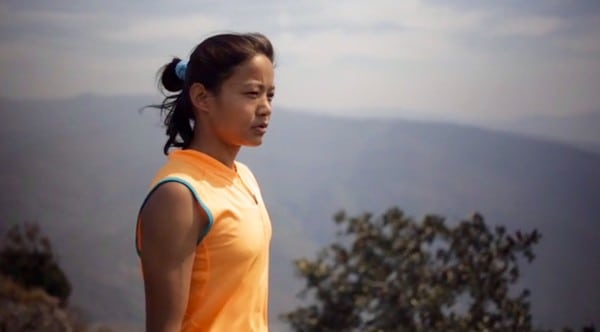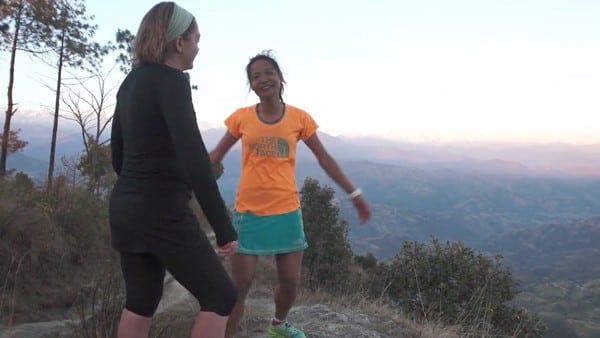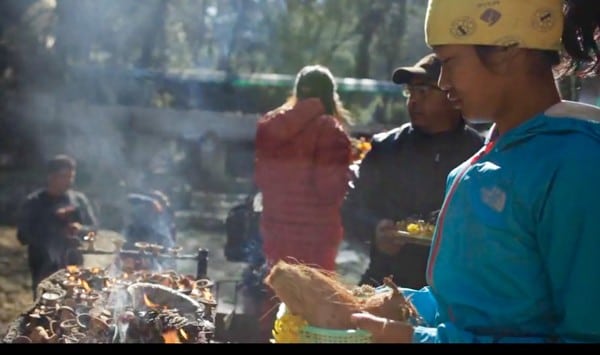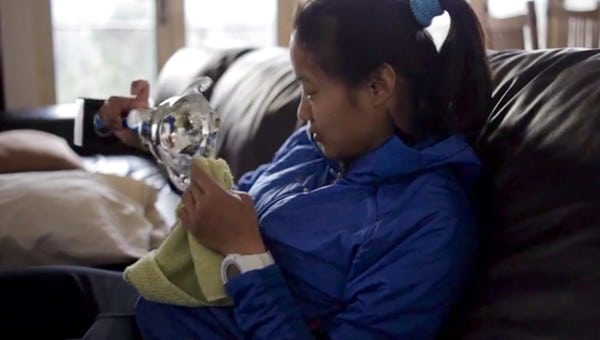The path of Nepalese trail runner Mira Rai’s life must be about as statistically improbable as winning the lottery, getting struck by lightning, or something equally obscure. Now in the second half of her twenties and facing down her second year of international trail racing, but born into an impoverished family in a patriarchal society, it would probably take much longer than the length of Mira, a 42-minute film about her created by filmmaker Lloyd Belcher, to let her trajectory tangibly sink in.
In fact, as a woman born into middle-class America with opportunities laying on a proverbial silver platter before me relative to the opportunities available to her, I’m not sure I–or anyone like me–can truly wrap our brains around Mira’s story.
But what is borderline impossible to comprehend is also compelling, and so we can’t help but try.
There is also an element of ‘we must,’ if I can be perfectly honest. We are a sport made mostly of hobbyists, folks running around the woods and hills because it’s a good way to tick off our leisure hours and stay healthy. Mira’s a woman using the trails to carve an entirely new version of what life can be for herself and hopefully other Nepalese girls and women. That is, she’s trying to use our sport for good. It behooves us to pay attention.

Mira Rai. All images are screenshots from the film.
Via this film, filmmaker Lloyd helps us out with this, using a clear, mostly linear telling of Mira’s life history. Over the course of this film, viewers visit Mira’s childhood home with her and see the deeply impoverished life of subsistence agriculture into which she was born. We observe how she bucks Nepalese female stereotypes over and again, including joining the Maoist rebel army during the Nepalese Civil War and moving to Kathmandu alone to see if there is opportunity for life outside her remote village. We also see her play around with several sports, and watch her discover that she is an excellent trail runner.
By the end of the film, we’ve also traveled with Mira on her first year of competing in international trail running–2015, after only discovering the sport the year before–around the globe, to Italy, Hong Kong, Australia, France, and Spain. (Did I miss a trip?) We see that she has a breakout season, runs close to some of the top names in the sport, and establishes herself as a contender in steep mountain races.
Mira narrates her own story, via what feels like a carefully crafted script. She speaks in Nepali, which is translated in English subtitles. Here and there the narration breaks and we hear and see Mira interact in ‘real time,’ within the situation that is being filmed. Of course, I don’t understand what Mira is saying, but I am carried along by the sing-song inflections unique to the Nepali language and the rich texture of Mira’s voice. I find this narration lovely.

Mira Rai and Lizzy Hawker in Nepal.
Lloyd uses a variety of filmmaking techniques, and mostly those which are traditional to outdoor, documentary-style filmmaking. He skips some of the fad techniques we’ve been seeing in outdoor films of late, which I find refreshing–though he does rely a little too heavily for my liking on the use of a drone. The film is styled as a ground-level narrative; we viewers are meant to be in the moments with Mira, living and breathing with her. I don’t know much about filmmaking, but I do know about writing and I know that ground-level storytelling is incredibly difficult to effect in that medium. Done well, however, and it becomes a most intimate and powerful storytelling means. Watching scenes from a drone literally and figuratively lifts me away from that ground level, severing some of my connection to Mira.
There are juxtapositions everywhere in this film, those of socioeconomics, culture, gender, and more. Some feel startling, others clever, and some I just can’t draw my attention away from. Many of them feel part and parcel to Mira’s life story, what you’re going to get when you see a life like hers unfold. A few feel intentionally presented, perhaps as reminders to viewers of this woman’s unusual situation–though can we possibly forget? As examples, we see Mira wearing flashy trail running kit while running through the ridiculously arid and dusty hills of Nepal, walking the streets of Kathmandu and passing more traditionally dressed (and likely traditionally living) women her age, and praying at a shrine for success in her trail races. Also, there’s often this big Suunto watch on her arm, the value of which must be greater than many Nepalese people’s annual salaries.

Mira praying for good performances in trail racing.
My favorite scene takes place at about 13 minutes. Mira is stretching on a steep hillside, on what appears to be an early, chilly morning. Her body, which must be heated and sweating from some running she’s just done and poised in assertive and confident postures, gives off water vapor that catches light in the sun as it condenses. There is incredible symbolism here that extends well beyond the moment’s glorious aesthetic: Mira is starting to learn of her power as a trail runner. Just as the water vapor condenses into the air around her, Mira here seems turned outward, expressing herself into the world.
[Author’s Note: I learned after writing this review that the water vapor came from Mira’s tights being damp, rather than her sweat. She washed them the night before this shot was filmed, and put them on in the early morning when they were still damp. Random beauty!]

Mira stretching.
Since this is a trail running film, we are endowed with plenty of footage of Mira running. I know some viewers dislike too much running footage because a film takes on a Warren Miller quality–all action, no plot. Even if the scenes of Mira running don’t advance the film’s storyline much, some runners are just so enjoyable to watch run, and Mira is one of those people. She’s a bit more muscle-y and squared off than your typical sinewy endurance runner, and she’s used to navigating up and down the super steeps of Nepal, and so her running stride also looks a bit different. In her stride we observe a powerful sense of push-pull, an aggressive lean into the terrain that exudes confidence and capability, and incredible kick back–like that of a 400-meter runner. The unique qualities of her running stride–layered into the full-on global scenery in which we watch her run–make the running sections of the film an enjoyable watch for me.
When I view films for potential review, I scribble notes. I have a note from watching Mira that reads, “20 minutes in, so need Mira to emote.” The film lines out very well the intellectual details of her life’s evolution, but I find it to lack in sharing Mira’s emotional journey until its final quarter. I don’t know if this lack of emotion is intentional, to protect Mira, or a byproduct of hers and Lloyd’s personalities as protagonist and filmmaker. Around a half hour into the film, we get our first glimpses of the depths of emotion that Mira feels: we see her stroking and polishing her trophy from taking third place at a race in Australia and admitting that she’s disappointed in her performance. In this moment, we as viewers palpably feel Mira’s vulnerability and how tough she is on herself. I love this–being able to feel inside of me what stirs another woman into action–and so wish there was more of it in this film.

Mira polishing her trophy.
Mira was made with a small, donated budget and as a labor of love by Lloyd and few other helpers. Proceeds from the film–the money it makes from us renting it on Vimeo–will fund what Mira hopes will be the start to a girls’-sports revolution in Nepal. She wants to be a successful role model for other young women, to show them that there is more opportunity in life than what tradition beckons and that girls can participate successfully in sports. On the simple fact that your monies will help perpetuate Mira’s story, I recommend viewing this film. However, on the film’s own merit, I also recommend Mira. It’s a complex story presented simply and elegantly, and it’ll make you an impossibly dedicated fan of Mira Rai.
Below is the trailer for the film:
